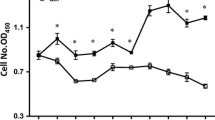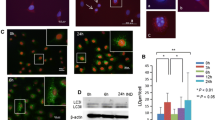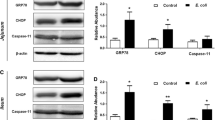Abstract
High intake of dietary cysteine is extremely toxic to animals and the underlying mechanism remains largely unknown. This study was conducted to test the hypothesis that excessive l-cysteine induces cell death by activating endoplasmic reticulum (ER) stress and mitogen-activated protein kinase (MAPK) signaling in intestinal porcine epithelial cells. Jejunal enterocytes were cultured in the presence of 0–10 mmol/L l-cysteine. Cell viability, morphologic alterations, mRNA levels for genes involved in ER stress, protein abundances for glucose-regulated protein 78, C/EBP homologous protein (CHOP), alpha subunit of eukaryotic initiation factor-2 (eIF2α), extracellular signal-regulated kinase (ERK1/2), p38 MAPK, and c-Jun N-terminal protein kinase (JNK1/2) were determined. The results showed that l-cysteine (5–10 mmol/L) reduced cell viability (P < 0.05) and led to vacuole-like cell death in intestinal porcine epithelial cells. These adverse effects of L-cysteine were not affected by the autophagy inhibitor 3-methyladenine. The protein abundances for CHOP, phosphorylated (p)-eIF2α, p-JNK1/2, p-p38 MAPK, and the spliced form of XBP-1 mRNA were enhanced (P < 0.05), whereas those for p-ERK1/2 were reduced (P < 0.05). Collectively, excessive l-cysteine induces vacuole-like cell death via the activation of ER stress and MAPK signaling in small intestinal epithelial cells. These signaling pathways may be potential targets for developing effective strategies to prevent the toxicity of dietary cysteine.






Similar content being viewed by others
Abbreviations
- CHOP:
-
C/EBP homologous protein
- DDIT3:
-
DNA damage-inducible transcript 3
- eIF2α:
-
Alpha subunit of eukaryotic initiation factor-2
- ER:
-
Endoplasmic reticulum
- ERK1/2:
-
Extracellular signal-regulated kinase
- FBS:
-
Fetal bovine serum
- GRP78:
-
Glucose-regulated protein 78
- HSPA5:
-
Heat shock 70 kDa protein 5
- HRP:
-
Horseradish peroxidase
- IPEC-1:
-
Intestinal porcine epithelial cell line 1
- JNK1/2:
-
c-Jun N-terminal protein kinase
- MAPK:
-
Mitogen-activated protein kinase
- PERK:
-
Protein kinase RNA-like endoplasmic reticulum kinase
- UPR:
-
Unfolded protein response
- XBP1s:
-
Spliced X-box binding protein 1
References
Baker DH (2006) Comparative species utilization and toxicity of sulfur amino acids. J Nutr 136(6 Suppl):1670S–1675S
Baumeister P, Luo S, Skarnes WC, Sui G, Seto E, Shi Y, Lee AS (2005) Endoplasmic reticulum stress induction of the Grp78/BiP promoter: activating mechanisms mediated by YY1 and its interactive chromatin modifiers. Mol Cell Biol 25(11):4529–4540
Brosnan JT, Brosnan ME (2006) The sulfur-containing amino acids: an overview. J Nutr 136(6 Suppl):1636S–1640S
Chen L, Li P, Wang J, Li X, Gao H, Yin Y, Hou Y, Wu G (2007) In vitro oxidation of essential amino acids by intestinal mucosal cells of growing pigs. Livest Sci 109:19–23
Chen L, Li P, Wang J, Li X, Gao H, Yin Y, Hou Y, Wu G (2009) Catabolism of nutritionally essential amino acids in developing porcine enterocytes. Amino Acids 37(1):143–152
Chen S, Melchior WB Jr, Guo L (2014) Endoplasmic reticulum stress in drug- and environmental toxicant-induced liver toxicity. J Environ Sci Health C Environ Carcinog Ecotoxicol Rev 32(1):83–104
Dai ZL, Wu ZL, Jia SC, Wu G (2014) Analysis of amino acid composition in proteins of animal tissues and foods as pre-column o-phthaldialdehyde derivatives by HPLC with fluorescence detection. J Chromatogr B 964:116–127
Darling NJ, Cook SJ (2014) The role of MAPK signalling pathways in the response to endoplasmic reticulum stress. Biochim Biophys Acta 1843(10):2150–2163
Dilger RN, Baker DH (2008) Excess dietary l-cysteine causes lethal metabolic acidosis in chicks. J Nutr 138(9):1628–1633
Dilger RN, Toue S, Kimura T, Sakai R, Baker DH (2007) Excess dietary l-cysteine, but not L-cystine, is lethal for chicks but not for rats or pigs. J Nutr 137(2):331–338
El-Khairy L, Ueland PM, Nygard O, Refsum H, Vollset SE (1999) Lifestyle and cardiovascular disease risk factors as determinants of total cysteine in plasma: the Hordaland Homocysteine Study. Am J Clin Nutr 70(6):1016–1024
El-Khairy L, Vollset SE, Refsum H, Ueland PM (2003) Plasma total cysteine, pregnancy complications, and adverse pregnancy outcomes: the Hordaland Homocysteine Study. Am J Clin Nutr 77(2):467–472
Garcia-Navas R, Munder M, Mollinedo F (2012) Depletion of l-arginine induces autophagy as a cytoprotective response to endoplasmic reticulum stress in human T lymphocytes. Autophagy 8(11):1557–1576
Gonzalez-Polo RA, Boya P, Pauleau AL, Jalil A, Larochette N, Souquere S, Eskelinen EL, Pierron G, Saftig P, Kroemer G (2005) The apoptosis/autophagy paradox: autophagic vacuolization before apoptotic death. J Cell Sci 118(Pt 14):3091–3102
Guan D, Xu Y, Yang M, Wang H, Wang X, Shen Z (2010) N-acetyl cysteine and penicillamine induce apoptosis via the ER stress response-signaling pathway. Mol Carcinog 49(1):68–74
Haynes TE, Li P, Li XL, Shimotori K, Sato H, Flynn NE, Wang JJ, Knabe DA, Wu G (2009) l-Glutamine or l-alanyl-l-glutamine prevents oxidant- or endotoxin-induced death of neonatal enterocytes. Amino Acids 37:131–142
Heafield MT, Fearn S, Steventon GB, Waring RH, Williams AC, Sturman SG (1990) Plasma cysteine and sulphate levels in patients with motor neurone, Parkinson’s and Alzheimer’s disease. Neurosci Lett 110(1–2):216–220
Kim HJ, Cho HK, Kwon YH (2008) Synergistic induction of ER stress by homocysteine and beta-amyloid in SH-SY5Y cells. J Nutr Biochem 19(11):754–761
Oyadomari S, Mori M (2004) Roles of CHOP/GADD153 in endoplasmic reticulum stress. Cell Death Differ 11(4):381–389
Ozkan Y, Ozkan E, Simsek B (2002) Plasma total homocysteine and cysteine levels as cardiovascular risk factors in coronary heart disease. Int J Cardiol 82(3):269–277
Rao RV, Peel A, Logvinova A, del Rio G, Hermel E, Yokota T, Goldsmith PC, Ellerby LM, Ellerby HM, Bredesen DE (2002) Coupling endoplasmic reticulum stress to the cell death program: role of the ER chaperone GRP78. FEBS Lett 514(2–3):122–128
Ron D, Walter P (2007) Signal integration in the endoplasmic reticulum unfolded protein response. Nat Rev Mol Cell Biol 8(7):519–529
Shoveller AK, Stoll B, Ball RO, Burrin DG (2005) Nutritional and functional importance of intestinal sulfur amino acid metabolism. J Nutr 135(7):1609–1612
Sperandio S, de Belle I, Bredesen DE (2000) An alternative, nonapoptotic form of programmed cell death. Proc Natl Acad Sci USA 97(26):14376–14381
Stipanuk MH (2004) Sulfur amino acid metabolism: pathways for production and removal of homocysteine and cysteine. Annu Rev Nutr 24:539–577
Sun YL, Wu ZL, Li W, Zhang C, Sun KJ, Ji Y, Wang B, Jiao N, He BB, Wang WW, Dai ZL, Wu G (2015) Dietary l-leucine supplementation enhances intestinal development in suckling piglets. Amino Acids 47(8):1517–1525
Szegezdi E, Logue SE, Gorman AM, Samali A (2006) Mediators of endoplasmic reticulum stress-induced apoptosis. EMBO Rep 7(9):880–885
Townsend DM, Tew KD, Tapiero H (2004) Sulfur containing amino acids and human disease. Biomed Pharmacother 58(1):47–55
Urano F, Wang X, Bertolotti A, Zhang Y, Chung P, Harding HP, Ron D (2000) Coupling of stress in the ER to activation of JNK protein kinases by transmembrane protein kinase IRE1. Science 287(5453):664–666
Wang WW, Dai ZL, Wu ZL, Lin G, Jia SC, Hu SD, Dahanayaka S, Wu G (2014) Glycine is a nutritionally essential amino acid for maximal growth of milk-fed young pigs. Amino Acids 46:2037–2045
Wang H, Zhang C, Wu G, Sun YL, Wang B, He BB, Dai ZL, Wu ZL (2015a) Glutamine enhances tight-junction protein expression and modulates CRF signaling in the jejunum of weanling piglets. J Nutr 145:25–31
Wang H, Ji Y, Wu G, Sun KJ, Sun YL, Li W, Wang B, He BB, Zhang Q, Dai ZL, Wu ZL (2015b) l-Tryptophan activates mammalian target of rapamycin and enhances expression of tight junction proteins in intestinal porcine epithelial cells. J Nutr 145:1156–1162
Wu G (2013) Amino acids: biochemistry and nutrition. CRC Press, Boca Raton
Wu G (2014) Dietary requirements of synthesizable amino acids by animals: a paradigm shift in protein nutrition. J Anim Sci Biotechnol 5:34
Wu YT, Tan HL, Shui G, Bauvy C, Huang Q, Wenk MR, Ong CN, Codogno P, Shen HM (2010) Dual role of 3-methyladenine in modulation of autophagy via different temporal patterns of inhibition on class I and III phosphoinositide 3-kinase. J Biol Chem 285(14):10850–10861
Wu G, Bazer FW, Dai ZL, Li DF, Wang JJ, Wu ZL (2014) Amino acid nutrition in animals: protein synthesis and beyond. Annu Rev Anim Biosci 2:387–417
Yang Y, Li W, Sun Y, Han F, Hu CA, Wu Z (2014) Amino acid deprivation disrupts barrier function and induces protective autophagy in intestinal porcine epithelial cells. Amino Acids. doi:10.1007/s00726-014-1844-6
Zeng X, Overmeyer JH, Maltese WA (2006) Functional specificity of the mammalian Beclin-Vps34 PI 3-kinase complex in macroautophagy versus endocytosis and lysosomal enzyme trafficking. J Cell Sci 119(Pt 2):259–270
Zinszner H, Kuroda M, Wang X, Batchvarova N, Lightfoot RT, Remotti H, Stevens JL, Ron D (1998) CHOP is implicated in programmed cell death in response to impaired function of the endoplasmic reticulum. Genes Dev 12(7):982–995
Acknowledgments
This work was supported by the National Basic Research Program of China (No. 2013CB127302), the National Natural Science Foundation of China (No. 31172217, 31272450, 31272451), the Chinese Universities Scientific Fund (2013RC002), the Program for New Century Excellent Talents in University (NCET-12-0522), and the Program for Beijing Municipal Excellent Talents, the Agriculture and Food Research Initiative Competitive Grant from the USDA National Institute of Food and Agriculture (No. 2014-67015-21770), and Texas A&M AgriLife Research (H-8200).
Author information
Authors and Affiliations
Corresponding author
Ethics declarations
Conflict of interest
The authors declare that they have no conflict of interest.
Rights and permissions
About this article
Cite this article
Ji, Y., Wu, Z., Dai, Z. et al. Excessive l-cysteine induces vacuole-like cell death by activating endoplasmic reticulum stress and mitogen-activated protein kinase signaling in intestinal porcine epithelial cells. Amino Acids 48, 149–156 (2016). https://doi.org/10.1007/s00726-015-2071-5
Received:
Accepted:
Published:
Issue Date:
DOI: https://doi.org/10.1007/s00726-015-2071-5




